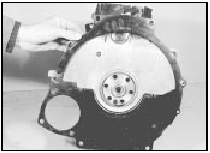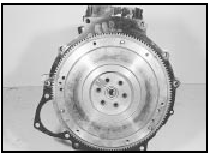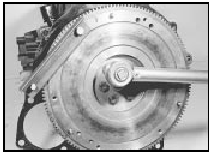Flywheel/driveplate - removal, inspection and refitting
Note: The manufacturers recommend that the flywheel/driveplate securing bolts are renewed after slackening. Suitable thread-locking agent will be required to coat the bolt threads.
Removal
1 If the engine is in the vehicle, remove the
clutch or the automatic transmission, as
applicable.
2 Prevent the flywheel/driveplate from turning by jamming the ring gear teeth or by bolting a strap between the flywheel/driveplate and the cylinder block.
3 Make alignment marks on the flywheel/driveplate and the end of the crankshaft, so that the flywheel/driveplate can be refitted in its original position.
4 Unscrew the securing bolts and withdraw the flywheel/driveplate. Do not drop it, it is very heavy. Note that on models with A4LD type automatic transmission, the driveplate may be secured with one or two reinforcing plates depending on model.
5 The engine adapter plate may now be withdrawn from the dowels if required (see illustration).

26.5 Withdrawing the engine adaptor plate
Inspection
6 With the flywheel/driveplate removed, the
ring gear can be examined for wear and
damage.
7 If the ring gear is badly worn or has missing teeth it should be renewed. The old ring can be removed from the flywheel/driveplate by cutting a notch between two teeth with a hacksaw and then splitting it with a cold chisel. Wear eye protection when doing this.
8 Fitting of a new ring gear requires heating the ring to 400ºF (204ºC). This can be done by polishing four equally spaced sections of the gear, laying it on a heat resistant surface (such as fire bricks) and heating it evenly with a blow lamp or torch until the polished areas turn a light yellow tinge. Do not overheat, or the hard wearing properties will be lost. The gear has a chamfered inner edge which should fit against the shoulder on the flywheel. When hot enough, place the gear in position quickly, tapping it home if necessary, and let it cool naturally without quenching in any way.
Refitting
9 Commence refitting of the
flywheel/driveplate by refitting the engine
adapter plate to the dowels on the rear of the
cylinder block, where applicable.
10 Ensure that the mating faces are clean, then locate the flywheel/driveplate on the rear of the crankshaft, aligning the previously made marks (see illustration).

26.10 Flywheel located on crankshaft
11 Coat the threads of the securing bolts with a liquid thread-locking agent, then insert the bolts. Note that the manufacturers recommend the use of new bolts. Where applicable refit the reinforcing plate(s) on models with A4LD type automatics 12 Prevent the flywheel/driveplate from turning as described in paragraph 2, then tighten the securing bolts to the specified torque in a diagonal sequence (see illustration).

26.12 Use a strap to prevent the flywheel turning as its securing bolts are
tightened
13 If the engine is in the vehicle, refit the clutch or the automatic transmission, as applicable.
See also:
Steering column - removal and refitting
Removal
1 Set the front wheels in the straight-ahead
position.
2 Disconnect the battery negative lead.
3 Remove the driverís side lower facia trim
panels.
4 Remove the screws and withdraw the
s ...
Fuel pump - testing, removal and refitting
Note: Refer to the warning at the end of
Section 1 before proceeding.
Testing
1 The fuel pump may be quite simply tested
by disconnecting the fuel inlet pipe from the
carburettor and placing its ...
Fuel pump - removal and refitting
Caution: Refer to the
precautions in Section 1 before
proceeding.
Mechanical pump
Note: A new gasket must be used when
refitting the pump.
1 Disconnect the battery negative lead.
2 For improved ...
